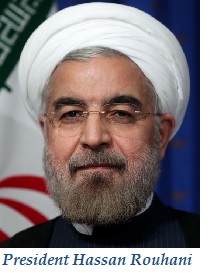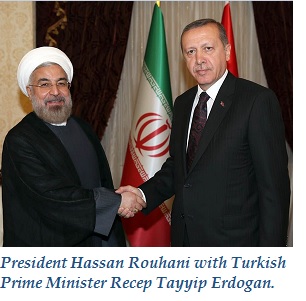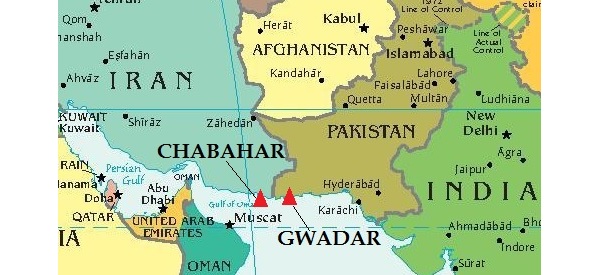Garrett Nada
President Hassan Rouhani made significant headway in stabilizing Iran’s economy in 2014. During his first full calendar year in office, he began addressing mismanagement and corruption from President Mahmoud Ahmadinejad’s tenure. His policies brought inflation down from 39 percent to 17 percent. After two years of recession, Iran’s economy was expected to grow by 1.5 percent.
 But the Islamic Republic still faced daunting challenges. General unemployment was 10 percent and youth unemployment was more than double the national average, reaching 24 percent. Some seven million Iranians, about eight percent of the population, were also living in extreme poverty.
But the Islamic Republic still faced daunting challenges. General unemployment was 10 percent and youth unemployment was more than double the national average, reaching 24 percent. Some seven million Iranians, about eight percent of the population, were also living in extreme poverty.
Rouhani took a pragmatic approach to domestic reforms, in contrast to the inefficient populist policies of the Ahmadinejad years. In April, the government cut subsidies on gasoline, which sent prices soaring by 75 percent. It also appealed affluent and middle-class Iranians to forego $18 monthly handouts initiated under Ahmadinejad. Although 73 million people, or about 95 percent of the population signed up, Tehran projected monthly savings of $482 million because 2.4 million waived the payments.
Nuclear diplomacy offered a slight reprieve too. The interim deal—implemented in January and extended twice in July and November—suspended some sanctions and allowed repatriation of oil revenues frozen in banks abroad. Iran gained access to $4.2 billion in frozen assets during the first six months, then another $2.8 billion from July to November.
Anticipation of a nuclear agreement that eased sanctions generated international commercial interest in Iran. At the World Economic Forum, Rouhani appealed for new investment. Dozens of groups from Europe, Asia and Latin American visited Iran to assess opportunities and build relationships. In October, Boeing’s small sale of aircraft manuals, drawings and navigation charts to Iran Air carried symbolic weight as the first transaction between U.S. and Iranian aerospace companies since the 1979 U.S. Embassy takeover.
But Tehran’s failure to get a deal with the world’s six major powers—and in turn ease more sanctions—was a major impediment to generating new jobs, new investment and new revenues. Recovery would require increased access to foreign exchange, oil markets and global financial flows.
In 2014, Rouhani targeted corruption to account for billions lost during the Ahmadinejad years. An investigation of celebrity businessman Babak Zanjani revealed a deep network of corruption that extended from Iran to Turkey, Tajikistan to Malaysia. Zanjani also owed Iran’s oil ministry $2 billion. The Ahmadinejad administration reportedly had Zanjani help evade sanctions and sell oil abroad and transfer money through overseas banks. But Zanjani apparently never transferred the money back to the oil ministry.
Plummeting oil prices were Iran’s biggest challenge. In December, Rouhani was forced to present a budget for 2015 based on an average oil price of only $70 per barrel, slashed from $100 per barrel in the 2014 budget. He also vowed to reduce Iran’s dependence on oil from an average of 45 percent of all revenues to about 31.5 percent.
At the same time, however, the Rouhani government proposed a 33 percent hike in defense spending. The proposal notably included a 50 percent increase, to about $6.5 billion, for the Revolutionary Guards, a reflection that Iran had begun to build diplomatic bridges but still had broad and basic security concerns.
Highlights
● Inflation was
down to about 17 percent in December from about 39 percent in January.
● Under the interim nuclear deal, Iran was granted moderate sanctions relief and access to some $7 billion in frozen assets held overseas.
● Dozens of political and business delegations visited Iran in 2014. But most companies held back from investing or signed memorandums of understanding stipulating that business would begin only when sanctions are lifted.
● Rouhani’s government took some steps toward domestic reform, including cutting the subsidy on gasoline and tackling corruption.
Chronology
Jan. 7 – Minister of Science, Research and Technology Reza Faraji Dana
estimated that brain drain cost Iran’s economy some $150 billion annually as a result of 150,000 highly skilled individuals emigrating each year.
Jan. 14 – In its Global Economic Prospects, The World Bank
estimated that Iran’s economy shrunk by 1.7 percent in 2013. The bank projected a growth rate of 1.5 percent for 2014.
Jan. 23 – President Rouhani
announced Iran’s intention to “reopen trade, industrial and economic relations” with all of its neighbors in an
address at the World Economic Forum. He claimed Iran’s economy “has the potential to be among the world’s top 10 in the next three decades.”
Feb. 5 – In a televised interview, President Rouhani expressed regret for problems with distribution of food rations, after three people reportedly died waiting in line in subzero weather. His administration had extended the food aid program from 3 million people to 17 million to counter inflation. Rations included cheese, chicken, cooking oil, eggs and rice.
Late Feb. – India’s January oil shipments from Iran more than doubled compared to December, resulting in the highest monthly shipments since February 2012, due largely to Indian purchases after sanctions were eased.
March 12 – Iran sealed a
deal to export 10 billion cubic meters of gas per year to Oman during President Rouhani’s first visit to Muscat. The 25-year deal was valued at some $60 billion. Oman committed to building an underwater pipeline to Iran.
April 14 – The Statistical Center of Iran
reported that the average unemployment rate for the Persian year that ended on March 20 was 10.4 percent, down from 12.2 percent in March 2013. Female unemployment was 19.8 percent, more than double the rate for men at 8.6 percent. Youth unemployment was even higher at 24 percent for those between ages 15 and 24.
April 14 – Deputy Energy Minister Rahim Meydani warned that
water shortfalls could impact nearly half of Iran’s population, some 37 million people, in the summer if consumption wasn’t cut by up to 20 percent.
April 16 – The IMF said Iran’s economy showed signs of stability under President Rouhani, but noted that the “near-term economic outlook remains uncertain,” in its first comprehensive report in two years.
April 23 – 73 million citizens — some 95 percent of Iranians — signed up for cash handouts, despite government attempts to discourage affluent and middle-class families from registering for the $18 monthly
payments. Tehran was projected to save some $482 million per month after some 2.4 million waived the handouts.
April 25 – Subsidy cuts on gasoline raised the
price of gasoline 75 percent to 7,000 rials for the first 60 liters, up from 4,000 rials. The price of each additional liter beyond 60 was raised to 10,000 rials from 7,000.
April 27 – Rostam Ghasemi, head of the Iran-Iraq Economic Development Committee and a former oil minister, traveled to Erbil and signed an
agreement with Iraq’s Kurdish Regional Government to build oil and natural gas pipelines. The Kurdish government would receive 3 to 4 million liters of refined oil and natural gas in return for pumping crude oil to Iran.
April 29 – The National Iranian Oil Company
cancelled a $2.5 billion deal with China National Petroleum Corporation for developing the giant South Azadegan oil field. The project had been stymied by repeated delays.
May 6- 9 – Tehran
hosted its 19th annual International Oil, Gas, Refining and Petrochemical Exhibition, drawing some 600 energy companies from 32 countries. Some 1,200 domestic companies attended the show.
Mid-May – The IMF
projected real GDP growth rates of 1.5 percent for 2014 and 2.3 percent for 2015.
May 24 – Billionaire businessman Mahafarid Amir Khosravi was executed at Evin prison over a scandal that cost 14 state-owned and private banks almost $2.6 billion, reportedly the largest
fraud in Iran’s history.
Late May – Tehran and Islamabad
extended the deadline to complete the multi-billion-dollar gas pipeline from December 2014 to December 2015. The nearly 1,000 mile pipeline would help Pakistan deal with its overwhelming energy needs.
 June 9-10 –
June 9-10 –Iran and Turkey signed 10 cooperation agreements on tourism, joint ventures and customs cooperation during President Rouhani’s
visit to Ankara, the first official visit by an Iranian president in 18 years. Turkey sought a discount on Iranian gas but the two sides failed to agree on a
price.
June 23 – Iran
announced that Russia’s state nuclear power company Rosatom will build two more nuclear reactors at the Bushehr power plant. Rosatom expects to start construction before the end of 2014. The announcement came as the company’s deputy director general, Nikolai Spassky,
visited Tehran.
June 23 – Foreign tourist visits to Iran climbed
215 percent in spring 2014 compared to 2013, according to the deputy director of Iran’s Cultural Heritage, Tourism and Handicrafts Organization. “Over 23,600 foreign tourists visited Iran in the three-month period, compared with 7,500 last year,” said Morteza Rahmani-Movahed.
June 26 – India paid Iran $550 million to partly clear pending oil dues, in accordance with the interim nuclear deal that allows Tehran to repatriate blocked funds across the world.
June 29 – Iran
transferred about $776.3 million worth of shares of state-run companies to the private sector in spring 2014, according to Tasnim News Agency.
June 29 – Iran started
exporting cars to Russia for the first time in five years. Iran-Khodro stopped shipping vehicles to Russia in 2009 when it adopted stricter Euro-5 emission standards. Iran’s largest auto manufacturer revealed plans to export 10,000 cars to Russia by 2015.
July 8 – India paid a second tranche of $550 million to Iran in oil payments under the interim nuclear deal.
July 24 – India
paid a third tranche of $550 million to Iran in oil payments under the interim nuclear deal. India imported 281,000 bpd of Iranian crude oil from January to June, up by a
third compared to the same period last year, according to
Reuters.
July 29 – The cumulative impact of U.S. sanctions since 2011 cost Iran some $120 billion in oil revenues as of July, according to the Treasury Undersecretary for Terrorism and Financial Intelligence
David S. Cohen. “Iran's currency, the rial, has depreciated by about 50 percent since January 2012 and has declined by about 7 percent since the JPOA was announced last November,” he told the Senate Committee on Foreign Relations.
July 31 – China, Iran's biggest oil buyer, imported nearly 50 percent more in the first half of 2014 than in 2013, according to data collected by
Reuters. Purchases by Japan and Korea were down compared to 2013. But the combined purchases of China, India, Japan and Korea were up nearly 25 percent from last year, at 1.2 million barrels per day versus 961,236.
Sept. 25 – The Central Bank of Iran
announced that the economy grew for the first time in two previous Persian years. The economy expanded 4.6 percent in the first quarter of the year that started on March 21.
Oct. 4 – Iran
exported $16.7 billion worth of non-oil goods during the first half of the current Iranian calendar year. Exports to Asia, which accounted for 93 percent of total exports, increased by nine percent in comparison to the same period last year. And exports to Europe increased by 33 percent.
Oct. 9 – Iran’s economy was projected to
grow 2.2 percent in terms of real gross domestic product in 2015, according to the IMF’s World Economic Outlook for October.
Oct. 22 – Boeing, a U.S.-based aerospace and defense company,
announced that it sold aircraft manuals, drawings, navigation charts and data to Iran Air. The sale marked the first publically acknowledged transaction between U.S. and Iranian aerospace companies since the 1979 U.S. Embassy takeover.
Oct. 26 – Some seven million Iranians, about eight percent of the population, were living in extreme
poverty, according to Minister of Labor, Cooperatives and Social Welfare Ali Rabiei.
Oct. 29 – Crude oil revenues were
cut by about 30 percent, according to President Rouhani. The president was likely referring to falling market prices worldwide.
Oct. 29 – Iran was ranked 130 out of 189 economies by the World Bank in its new Doing Business
report, two positions higher than last year. The report measured regulations affecting 11 areas of the life of a business.
Nov. 10 – Government spokesperson Mohammad Bagher Nobakht told the state news agency that the Supreme Administrative Council
approved the reinstitution of the Planning and Budget Organization, which was merged with another organization in 2000 under President Mohammad Khatami and dissolved by President Mahmoud Ahmadinejad in 2007.
Nov. 20 – India
paid another $400 million to Iran in oil payments under the interim nuclear deal.
Nov. 26 – South Korea
transferred $500 million to Iran in oil payments.
Dec. 1 – The government implemented a 30 percent
increase in bread prices. Mojtaba Khosrotaj, the deputy minister of industry, mines and trade,
said the decision was made after some 70,000 bakeries complained about low prices.
Dec. 1 – Iran’s trade deficit
increased by less than $3 billion in the first eight months of the Iranian year that started in March, according to official customs data. Iran imported some $34 billion worth of goods, mainly food and automobiles, from China, India, South Korea and Turkey while it exported about $31 billion worth of goods, mainly to Afghanistan, China, India, Iraq and the United Arab Emirates.
Dec. 1 – Tehran hosted an international auto conference, which gathered more than 500 representatives from some 250 companies and 30 countries. The French ambassador to Tehran, who attended the event,
said that his country’s companies are just waiting for constrains imposed by sanctions to loosen before investing.
Dec. 2 –During a visit to Tehran, Qatar’s minister of labor
signed a memorandum of understanding that would send Iranian workers to the Gulf country. The move was aimed at helping Iran with its unemployment problems by providing Qatar with skilled workers.
Dec. 3 – President Rouhani
attended the inauguration of a new 570-mile railroad connecting Iran to Turkmenistan and Kazakhstan that took seven years to build.
Dec. 4 – Parliament passed a resolution that would allow the taxing of religious foundations and military-linked companies, including those overseen by the supreme leader.
Dec. 7 – President Rouhani presented his budget of some 8,400 trillion rials, or about $312 billion at the official exchange rate, to parliament. It was based on an average oil price of about $70, down $30 compared to last year. The budget also included a 33 percent hike in defense spending.
Dec. 9 – Iran and Pakistan
signed five memorandums of understanding to increase cooperation and enhance trade ties. One memorandum aimed to establish a sisterhood relationship between Iran’s ports of Shahid Rajaee and Chabahar with Pakistan’s ports of Karachi and Gwadar.
Dec. 11 – More than 722,300 cars were reportedly
manufactured since March, indicating nearly a 70 percent growth compared to the same period last year.
 But the Islamic Republic still faced daunting challenges. General unemployment was 10 percent and youth unemployment was more than double the national average, reaching 24 percent. Some seven million Iranians, about eight percent of the population, were also living in extreme poverty.
But the Islamic Republic still faced daunting challenges. General unemployment was 10 percent and youth unemployment was more than double the national average, reaching 24 percent. Some seven million Iranians, about eight percent of the population, were also living in extreme poverty. June 9-10 –Iran and Turkey signed 10 cooperation agreements on tourism, joint ventures and customs cooperation during President Rouhani’s visit to Ankara, the first official visit by an Iranian president in 18 years. Turkey sought a discount on Iranian gas but the two sides failed to agree on a price.
June 9-10 –Iran and Turkey signed 10 cooperation agreements on tourism, joint ventures and customs cooperation during President Rouhani’s visit to Ankara, the first official visit by an Iranian president in 18 years. Turkey sought a discount on Iranian gas but the two sides failed to agree on a price.
